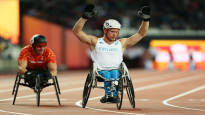Finnish para-peak sports is presented today, Tuesday, in the heart of Helsinki, at a public event for the entire nation, in connection with the Paralympic Games starting in Paris on August 28. Even though it’s going to be fun, behind the scenes in Finnish para sports, which is used to success, it’s a completely different atmosphere.
The Narinkkator event will also feature Finland’s most successful para athlete of all time, a wheelchair curler Leo-Pekka Tähtiwho ends his top sports career in his main sport in Paris. When the person from Pori debuted at the Paralympic level in 2004 in Athens, the Finnish team had 86 athletes. After this, the numbers have collapsed so that both in Tokyo 2021 and now in Paris, Finland only got a team of 16 athletes.
Tähti tells Urheilu that he would not be surprised if less than 10 Finnish athletes were seen in Los Angeles at the 2028 Games. That would be quite a blow for the country, which during the summer Paralympic tradition that started in 1960 has achieved 75 gold, 100 silver and 105 bronze.
– In para sports, the journey to the top takes 5-8 years, which means that we are already late for Los Angeles. The outlook is very worrying, Tähti states.
Also the sports director of the umbrella organization of parasports, the Finnish Paralympic Committee Katja Saarinen admits that there is a reason for the crisis mood.
– The situation is very alarming. The numbers prove it.
Inevitable crisis
The situation will inevitably become critical in the coming years already because, after Paris, among Finland’s elite level para-athletes, at least at this level, the wheelchair curlers Tähti and Toni Piispanen and rider Katja Karjalainen. Thrower Marjaana Heikkinen is 57 years old. A wheelchair curler who was not selected for Paris, a multiple prize winner Esa-Pekka Mattila is also ending his career.
Katja Saarinen reminds that the situation in winter sports is not much better than the long-term winners Santeri Kiiveri and Matti Suur-Hamari have finished.
The significant decrease in Finnish competition teams is partly explained by the fact that Finland has no longer passed the qualifying rounds of highly competitive team games such as goalball or sitting volleyball.
1992: 71 athletes; 1996: 67; 2000: 65; 2004: 86; 2008: 31; 2012: 35; 2016: 27; 2021: 16; 2024: 16.
The situation has also been watched with great concern by one of Finland’s best para-athletes, who plays wheelchair table tennis Only Tapolan coach Martti Autio.
– In 2020, a total of 18 para sports received support from the Olympic Committee’s top sports unit, this year only 10. Now there are Finns in only six sports in the Paris Games.
Public support for para sports, i.e. athlete grants and elite sports unit support, is 600,000-700,000 euros per year.
Several reasons
Both Tähti, Saarinen and Autio easily find several reasons for the decline of para-elite sports in Finland. Professional, paid coaching is practically impossible in Finland, and that is why, for example, Tähti sees his future as a bowling coach entirely abroad. Even if para sports were integrated as part of the activities in the sports federations, it still receives very little attention from the whole.
Enthusiast recruitment slows down, among other things, because very few clubs invest in para sports and run meaningful and active activities through it. It also means that the undergrowth necessary for top sports, i.e. national competitive sports, will remain very pale.
At the same time, global competition in para sports has also intensified enormously, and in many countries professional projects are run around certain sports.
A shock to the power of two?
According to the star, there is a cycle of evil going on.
– Fading success reduces the money and resources coming into the sport, which weakens the success even more. If everything goes according to the worst-case scenario, everything will be reduced to the power of two and the whole thing will have to be built from scratch. It would be a huge shame, because para sports has gained quite a lot of visibility and popularity in Finland with hard work, says Tähti, who was chosen as Athlete of the Year 2016.
However, the crisis in para-sports has been acknowledged, and after the games that end in Paris on September 8, the results of an extensive research project will be heard. Toni Piispanen, who works at the State Sports Council, was the driving force behind the start.
The research project funded by the Ministry of Education was led by the CEO of the main training center for para sports, i.e. Liikuntakeskus Pajulahti, former secretary general of the Paralympic Committee Tero Kuorikoski.
Desired text
– Without going deeply into the results of the study to be published on September 12, it was of course a matter of great concern. We have listened to a large group of people right at the heart of the operation, and the final report contains very concrete change proposals in accordance with the terms of reference. In the various assessment projects of competitive and elite sports, para-sports has been neglected, says Kuorikoski.
According to the persons interviewed by Urheilu, the report contains very harsh but desirable text.
– The need for such research information has been dire. Better late than never, says Katja Saarinen.
Esa-Pekka Mattila, chairman of the Olympic Committee’s athlete committee, who narrowly missed out on Paris, is also waiting with great interest for the completion of the study. He reminds that research information can only be useful by converting it into practical measures. This has often been easier said than done in Finnish elite sports.
– Concerns have been expressed many times over the years about these things (the future of para-elite sports), for example the continuous decrease of para-competitive athletes. No terribly radical measures have been seen, but hopefully these research results will quickly and purposefully turn into practical corrective measures.
